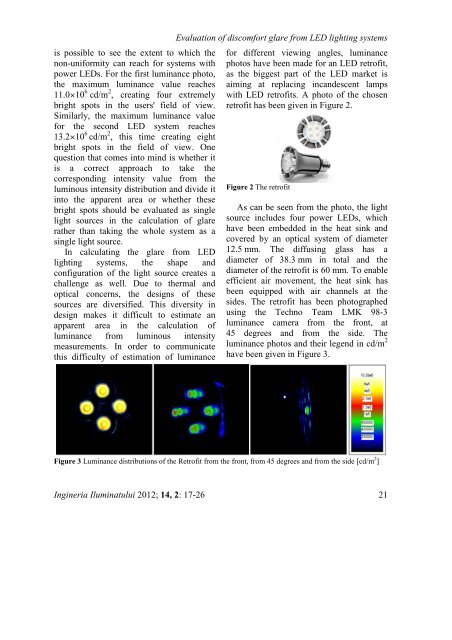Untitled - Journal of Lighting Engineering
Untitled - Journal of Lighting Engineering
Untitled - Journal of Lighting Engineering
You also want an ePaper? Increase the reach of your titles
YUMPU automatically turns print PDFs into web optimized ePapers that Google loves.
is possible to see the extent to which the<br />
non-uniformity can reach for systems with<br />
power LEDs. For the first luminance photo,<br />
the maximum luminance value reaches<br />
11.0 10 6 cd/m 2 , creating four extremely<br />
bright spots in the users' field <strong>of</strong> view.<br />
Similarly, the maximum luminance value<br />
for the second LED system reaches<br />
13.2 10 6 cd/m 2 , this time creating eight<br />
bright spots in the field <strong>of</strong> view. One<br />
question that comes into mind is whether it<br />
is a correct approach to take the<br />
corresponding intensity value from the<br />
luminous intensity distribution and divide it<br />
into the apparent area or whether these<br />
bright spots should be evaluated as single<br />
light sources in the calculation <strong>of</strong> glare<br />
rather than taking the whole system as a<br />
single light source.<br />
In calculating the glare from LED<br />
lighting systems, the shape and<br />
configuration <strong>of</strong> the light source creates a<br />
challenge as well. Due to thermal and<br />
optical concerns, the designs <strong>of</strong> these<br />
sources are diversified. This diversity in<br />
design makes it difficult to estimate an<br />
apparent area in the calculation <strong>of</strong><br />
luminance from luminous intensity<br />
measurements. In order to communicate<br />
this difficulty <strong>of</strong> estimation <strong>of</strong> luminance<br />
Evaluation <strong>of</strong> discomfort glare from LED lighting systems<br />
for different viewing angles, luminance<br />
photos have been made for an LED retr<strong>of</strong>it,<br />
as the biggest part <strong>of</strong> the LED market is<br />
aiming at replacing incandescent lamps<br />
with LED retr<strong>of</strong>its. A photo <strong>of</strong> the chosen<br />
retr<strong>of</strong>it has been given in Figure 2.<br />
Figure 2 The retr<strong>of</strong>it<br />
As can be seen from the photo, the light<br />
source includes four power LEDs, which<br />
have been embedded in the heat sink and<br />
covered by an optical system <strong>of</strong> diameter<br />
12.5 mm. The diffusing glass has a<br />
diameter <strong>of</strong> 38.3 mm in total and the<br />
diameter <strong>of</strong> the retr<strong>of</strong>it is 60 mm. To enable<br />
efficient air movement, the heat sink has<br />
been equipped with air channels at the<br />
sides. The retr<strong>of</strong>it has been photographed<br />
using the Techno Team LMK 98-3<br />
luminance camera from the front, at<br />
45 degrees and from the side. The<br />
luminance photos and their legend in cd/m 2<br />
have been given in Figure 3.<br />
Figure 3 Luminance distributions <strong>of</strong> the Retr<strong>of</strong>it from the front, from 45 degrees and from the side [cd/m 2 ]<br />
Ingineria Iluminatului 2012; 14, 2: 17-26 21
















